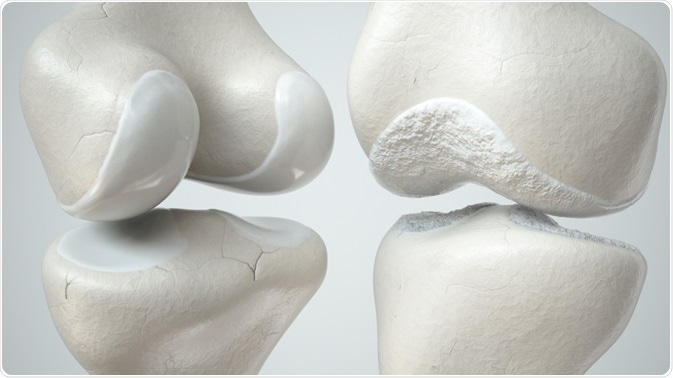There are many factors associated with a risk of acquiring osteoarthritis that may be responsible for causing the health condition. The following is a more detailed overview of the possible causes.
 Image Credit: Crevis/Shutterstock.com
Image Credit: Crevis/Shutterstock.com
Mechanical stress
The primary reason behind the development of osteoarthritis is insufficient self-repair of joints following damage from mechanical stress. This stress can present in a range of different forms such as:
- Bone misalignment (from congenital or pathogenic causes)
- Physical injury
- Excess body weight
- Loss of muscle strength around joint
- Peripheral nerve impairment causing uncoordinated movements
Each of these involves damage or additional stress to the joints of the body. With this extra demand, the body can find it difficult to meet the requirements and result in osteoarthritis of the joints.
There are some causes that have been commonly associated with osteoarthritis, despite the fact that there is very little evidence to support them. For example, exercise and using the joints regularly has not been found to increase the risk of the condition. Likewise, cracking knuckles has not been found to have an effect on the likelihood of developing osteoarthritis.
Genetics
There has been a significant amount of research to support a hereditary link to osteoarthritis. It has been observed that there is a greater prevalence of the disease among siblings and this association is more marked between identical twins.
It is speculated that during the evolutionary process involving the progression of the human race into bipeds, changes to the pelvis, hip join and spine occurred. This is thought to increase the genetic risk of osteoarthritis and the genetic defects were not likely to be selected against as the symptoms usually present after reproductive success.
However, genetics alone is not usually enough to cause the disease and is usually present with a number of risk factors to contribute to an increased susceptibility to the condition.
Medical history
Some particular health conditions are correlated to a higher risk of developing osteoarthritis. This includes previous joint injury, particularly those involving the knees, and obesity.
In addition to the mechanical stress on the joints that excess body weight poses, it is possible that there may be a metabolic link to body fat that has the potential to cause osteoarthritis. This suggestion has been brought forward following the observation that symptoms are often relieved from non-weight-bearing joints with the loss of weight.
Osteoarthritis - causes, symptoms, diagnosis, treatment & pathology
Menopause
It is widely accepted that the risk of osteoporosis increases significantly for women when their body undertakes changes throughout menopause, particularly in respect to men of the same age.
Female hormones estrogen and progesterone are thought to be protective against certain health conditions, including osteoarthritis. A study of mice supported this, showing that injections of female hormones had a protective effect against the condition.
As the levels of hormones change throughout menopause, the protective female hormones decrease in production dramatically. This is thought to cause weakening of the bone joints and eventually lead to osteoarthritis.
Secondary causes
Secondary causes involve other health conditions that are linked to an increased risk of osteoarthritis but are not directly responsible for causing the condition.
There are several possible secondary causes including:
- Alkaptonuria
- Congenital disorders of joints
- Diabetes
- Ehlers-Danlos Syndrome
- Hemochromatosis and Wilson’s disease
- Perthes’ disease and Lyme disease
- Chronic rheumatoid arthritis
- Gout
- Joint and ligament injury or deterioration
- Marfan syndrome
- Septic arthritis People with these conditions should be aware of their increased risk of osteoarthritis and should have some knowledge of presenting symptoms and methods to reduce the risk of the condition.
Further Reading